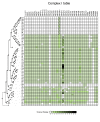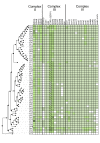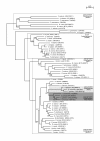Phylogenomics of the oxidative phosphorylation in fungi reveals extensive gene duplication followed by functional divergence
- PMID: 20025735
- PMCID: PMC2803194
- DOI: 10.1186/1471-2148-9-295
Phylogenomics of the oxidative phosphorylation in fungi reveals extensive gene duplication followed by functional divergence
Abstract
Background: Oxidative phosphorylation is central to the energy metabolism of the cell. Due to adaptation to different life-styles and environments, fungal species have shaped their respiratory pathways in the course of evolution. To identify the main mechanisms behind the evolution of respiratory pathways, we conducted a phylogenomics survey of oxidative phosphorylation components in the genomes of sixty fungal species.
Results: Besides clarifying orthology and paralogy relationships among respiratory proteins, our results reveal three parallel losses of the entire complex I, two of which are coupled to duplications in alternative dehydrogenases. Duplications in respiratory proteins have been common, affecting 76% of the protein families surveyed. We detect several instances of paralogs of genes coding for subunits of respiratory complexes that have been recruited to other multi-protein complexes inside and outside the mitochondrion, emphasizing the role of evolutionary tinkering.
Conclusions: Processes of gene loss and gene duplication followed by functional divergence have been rampant in the evolution of fungal respiration. Overall, the core proteins of the respiratory pathways are conserved in most lineages, with major changes affecting the lineages of microsporidia, Schizosaccharomyces and Saccharomyces/Kluyveromyces due to adaptation to anaerobic life-styles. We did not observe specific adaptations of the respiratory metabolism common to all pathogenic species.
Figures






Similar articles
-
Conservation, duplication, and loss of the Tor signaling pathway in the fungal kingdom.BMC Genomics. 2010 Sep 23;11:510. doi: 10.1186/1471-2164-11-510. BMC Genomics. 2010. PMID: 20863387 Free PMC article.
-
Phylogenomic evolutionary surveys of subtilase superfamily genes in fungi.Sci Rep. 2017 Mar 30;7:45456. doi: 10.1038/srep45456. Sci Rep. 2017. PMID: 28358043 Free PMC article.
-
Parallel evolution by gene duplication in the genomes of two unicellular fungi.Genome Res. 2003 Jun;13(6A):1259-64. Genome Res. 2003. PMID: 12901373
-
Evolutionary relationships between Saccharomyces cerevisiae and other fungal species as determined from genome comparisons.Rev Iberoam Micol. 2005 Dec;22(4):217-22. doi: 10.1016/s1130-1406(05)70046-2. Rev Iberoam Micol. 2005. PMID: 16499414 Review.
-
Genome duplication and gene-family evolution: the case of three OXPHOS gene families.Gene. 2008 Sep 15;421(1-2):1-6. doi: 10.1016/j.gene.2008.05.011. Epub 2008 Jun 23. Gene. 2008. PMID: 18573316 Review.
Cited by
-
A phylogenetic analysis of macroevolutionary patterns in fermentative yeasts.Ecol Evol. 2016 May 10;6(12):3851-61. doi: 10.1002/ece3.2097. eCollection 2016 Jun. Ecol Evol. 2016. PMID: 27516851 Free PMC article.
-
Using genomics to understand the mechanisms of virulence and drug resistance in fungal pathogens.Biochem Soc Trans. 2022 Jun 30;50(3):1259-1268. doi: 10.1042/BST20211123. Biochem Soc Trans. 2022. PMID: 35713390 Free PMC article. Review.
-
Deletion of the ATP2 Gene in Candida albicans Blocks Its Escape From Macrophage Clearance.Front Cell Infect Microbiol. 2021 Apr 16;11:643121. doi: 10.3389/fcimb.2021.643121. eCollection 2021. Front Cell Infect Microbiol. 2021. PMID: 33937095 Free PMC article.
-
Expansion of Signal Transduction Pathways in Fungi by Extensive Genome Duplication.Curr Biol. 2016 Jun 20;26(12):1577-1584. doi: 10.1016/j.cub.2016.04.038. Epub 2016 May 26. Curr Biol. 2016. PMID: 27238284 Free PMC article.
-
Genome Diversity and Evolution in the Budding Yeasts (Saccharomycotina).Genetics. 2017 Jun;206(2):717-750. doi: 10.1534/genetics.116.199216. Genetics. 2017. PMID: 28592505 Free PMC article. Review.
References
Publication types
MeSH terms
Substances
LinkOut - more resources
Full Text Sources
Medical

